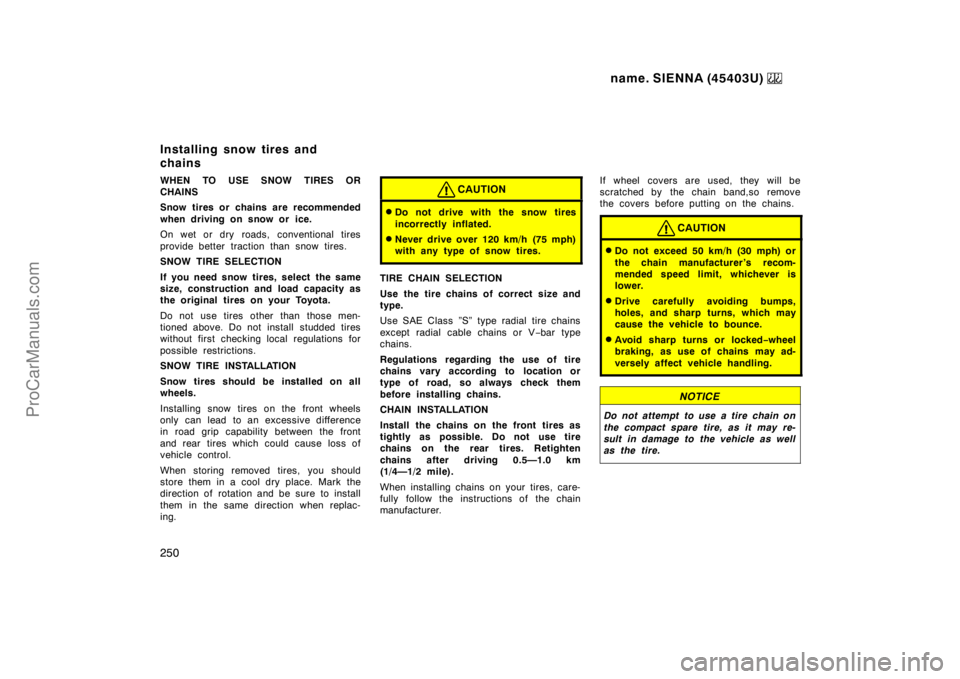Page 250 of 272

name. SIENNA (45403U)
250
WHEN TO USE SNOW TIRES OR
CHAINS
Snow tires or chains are recommended
when driving on snow or ice.
On wet or dry roads, conventional tires
provide better traction than snow tires.
SNOW TIRE SELECTION
If you need snow tires, select the same
size, construction and load capacity as
the original tires on your Toyota.
Do not use tires other than those men-
tioned above. Do not install studded tires
without first checking local regulations for
possible restrictions.
SNOW TIRE INSTALLATION
Snow tires should be installed on all
wheels.
Installing snow tires on the front wheels
only can lead to an excessive difference
in road grip capability between the front
and rear tires which could cause loss of
vehicle control.
When storing removed tires, you should
store them in a cool dry place. Mark the
direction of rotation and be sure to install
them in the same direction when replac-
ing.CAUTION
�Do not drive with the snow tires
incorrectly inflated.
�Never drive over 120 km/h (75 mph)
with any type of snow tires.
TIRE CHAIN SELECTION
Use the tire chains of correct size and
type.
Use SAE Class ”S” type radial tire chains
except radial cable chains or V−bar type
chains.
Regulations regarding the use of tire
chains vary according to location or
type of road, so always check them
before installing chains.
CHAIN INSTALLATION
Install the chains on the front tires as
tightly as possible. Do not use tire
chains on the rear tires. Retighten
chains after driving 0.5—1.0 km
(1/4—1/2 mile).
When installing chains on your tires, care-
fully follow the instructions of the chain
manufacturer.If wheel covers are used, they will be
scratched by the chain band,so remove
the covers before putting on the chains.
CAUTION
�Do not exceed 50 km/h (30 mph) or
the chain manufacturer ’s recom-
mended speed limit, whichever is
lower.
�Drive carefully avoiding bumps,
holes, and sharp turns, which may
cause the vehicle to bounce.
�Avoid sharp turns or locked−wheel
braking, as use of chains may ad-
versely affect vehicle handling.
NOTICE
Do not attempt to use a tire chain on
the compact spare tire, as it may re-
sult in damage to the vehicle as well
as the tire.
Installing snow tires and
chains
ProCarManuals.com
Page 251 of 272

name. SIENNA (45403U)
251
Replacing wheels
WHEN TO REPLACE YOUR WHEELS
If you have wheel damage such as
bending, cracks or heavy corrosion, the
wheel should be replaced.
If you fail to replace damaged wheels, the
tire may slip off the wheel or they may
cause loss of handling control.
WHEEL SELECTION
When replacing wheels, care should be
taken to ensure that the wheels are re-
placed by ones with the same load ca-
pacity, diameter, rim width, and offset.
This must be observed on compact spare
tires, too.
Correct replacement wheels are available
at your Toyota dealer.
A wheel of a different size or type may
adversely affect handling, wheel and bear-
ing life, brake cooling, speedometer/odom-
eter calibration, stopping ability, headlight
aim, bumper height, vehicle ground clear-
ance, and tire or snow chain clearance to
the body and chassis.Replacement with used wheels is not rec-
ommended as they may have been sub-
jected to rough treatment or high mileage
and could fail without warning. Also, bent
wheels which have been straightened may
have structural damage and therefore
should not be used. Never use an inner
tube in a leaking wheel which is designed
for a tubeless tire.
Aluminum wheel precautions
�After driving your vehicle the first 1600
km (1000 miles), check that the wheel
nuts are tight.
�If you have rotated, repaired, or
changed your tires, check that the
wheel nuts are still tight after driving
1600 km (1000 miles).
�When using tire chains, be careful not
to damage the aluminum wheels.
�Use only the Toyota wheel nuts and
wrench designed for your aluminum
wheels.
�When balancing your wheels, use only
Toyota balance weights or equivalent
and a plastic or rubber hammer.
�As with any wheel, periodically check
your aluminum wheels for damage. If
damaged, replace immediately.
ProCarManuals.com
Page 266 of 272
name. SIENNA (45403U)
266
Tires
Tire sizeTire pressure,
kPa (kgf/cm2 or bar, psi)Wheel size
P205/70R15 95S 240 (2.4, 35) 15 � 6.5JJ
220 (2.2, 32)
∗
1
240 (2.4, 35)∗
2
T145/80D16 420 (4.2, 60)
15 � 6.5JJ
16 � 4T P215/65R15 95S Normal driving
Trailer towing
Tire sizeTire pressure,
kPa (kgf/cm
2 or bar, psi)Wheel size
P205/70R15 95S 240 (2.4, 35) 15 � 6.5JJ
240 (2.4, 35)
15 � 6.5JJ P215/65R15 95S
When driving under the above vehicle load conditions at sustained high
speeds above 160 km/h (100 mph), in countries where such speeds are
permitted by−law, inflate the front and rear tires to 240 kPa (2.4 kgf/cm
2
or bar, 35 psi) provided that it does not exceed the maximum cold tire
pressure molded on the tire sidewall. Tire size and pressure:
∗
1: Vehicle load up to 6 passengers∗
2: Up to vehicle capacity weightWheel nut torque, N·m (kgf·m, ft·lbf):
104 (10.5, 77)
ProCarManuals.com